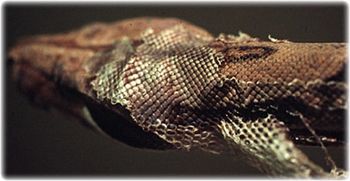Difference between revisions of "Snake Dysecdysis"
Siobhanbrade (talk | contribs) m (added Manson flashcard information) |
Siobhanbrade (talk | contribs) m (→Dysecdysis) |
||
| Line 13: | Line 13: | ||
Prior to shedding the [[Spectacle|spectacle]] becomes opaque and bluish-white from its normally transparent state. This results from a separation of the spectacle layers by a lymph-like fluid. In the wild this may render the snake partially blind and vulnerable to attack. During the actual shedding the spectacle returns to the transparent state. It is shed with the rest of the skin during [[Ecdysis|ecdysis]]. | Prior to shedding the [[Spectacle|spectacle]] becomes opaque and bluish-white from its normally transparent state. This results from a separation of the spectacle layers by a lymph-like fluid. In the wild this may render the snake partially blind and vulnerable to attack. During the actual shedding the spectacle returns to the transparent state. It is shed with the rest of the skin during [[Ecdysis|ecdysis]]. | ||
==Dysecdysis== | ==Dysecdysis== | ||
| − | Dysecdysis is improper or incomplete shedding. It may occur for various reasons including disease ([[Snake Mites|mites]], malnutrition, dermatitis or trauma) and problems of captivity (incorrect humidity, incorrect handling). Sometimes the spectacle fails to shed and remains as an opaque cover over the eye, restricting vision. | + | Dysecdysis is improper or incomplete shedding. It may occur for various reasons including disease ([[Snake Mites|mites]], endocrinopathies, malnutrition, dermatitis or trauma) and problems of captivity (incorrect humidity, incorrect handling). Sometimes the spectacle fails to shed and remains as an opaque cover over the eye, restricting vision. |
===Treatment=== | ===Treatment=== | ||
Revision as of 19:43, 12 September 2011
| This article has been peer reviewed but is awaiting expert review. If you would like to help with this, please see more information about expert reviewing. |
Introduction to shedding
The entire skin is shed on a regular basis, often two to four times a year. The frequency depends upon the rapidity of growth, age, nutritional state, size and environmental factors.
Find out more about the funcion and morphology of Snake Skin . Find out more about normal shedding in snakes
The process
Prior to shedding there is an inactive period of about a week during which the spectacle becomes opaque. Fissure-like clefts form between the inner dividing epidermal cells and the older cells as these migrate outward. A new three layered epidermis is formed under the old outer layers. Lymph diffuses into the area between the old and new skin and enzymes form a cleavage zone. Air is present between the two layers and interferes with ultrasonography. Ecdysis (shedding)then occurs as the snake rubs itself on objects in the environment to loosen the old skin. Most snakes shed their skin in one piece, except for the giant snakes that may tear their moult. The process takes in total about two weeks.
Spectacle
Prior to shedding the spectacle becomes opaque and bluish-white from its normally transparent state. This results from a separation of the spectacle layers by a lymph-like fluid. In the wild this may render the snake partially blind and vulnerable to attack. During the actual shedding the spectacle returns to the transparent state. It is shed with the rest of the skin during ecdysis.
Dysecdysis
Dysecdysis is improper or incomplete shedding. It may occur for various reasons including disease (mites, endocrinopathies, malnutrition, dermatitis or trauma) and problems of captivity (incorrect humidity, incorrect handling). Sometimes the spectacle fails to shed and remains as an opaque cover over the eye, restricting vision.
Treatment
Any snake with dysecdysis should be placed in a bath of tepid water for a minimum of 30 minutes and then placed between layers of dampened towels. As the animal crawls through the towel, this loosens and removes the soft epidermis. Additional treatment includes the application of contact lens solution on retained tertiary spectacles.
Prevention
A bath large enough for the snake to lie in should be placed in the cage. Sturdy rocks and logs should also be placed in the cage so the snake can start moulting by rubbing its chin on those structures.
Find out more information about helping to prevent dysecdysis using good husbandry.
| Snake Dysecdysis Learning Resources | |
|---|---|
 Test your knowledge using flashcard type questions |
Reptiles and Amphibians Q&A 14 |
References
Frye, FL & Williams, DL (1995) Self-Assessment Colour Review - Reptiles & Amphibians Manson
